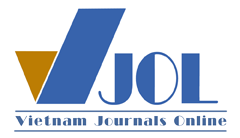Effect of operation paramaters on the filtration behavior in microfiltratration of TiO2 suspended
DOI:
https://doi.org/10.51316/jca.2021.014Keywords:
Microfiltration, TiO2 suspended, cake formation, membrane fouling, transmembrane pressure, permeate flux, resistance cakeAbstract
The photocatalytic reaction using TiO2 suspended to degrade the residues of toxic organic compounds has been extensively studied, but the ultilization of this process has not been recorded on an industrial scale. One of the primary reasons is the separation of TiO2 catalyst from the treated solution mixture. Conventional mechanical separation methods such as centrifugation, flocculation-deposition do not allow for thorough separation and catalytic reuse, whereas the microfiltration / ultrafiltration membrane process has been demonstrated to be capable of composting isolates very suspended particles. Accordingly, in this study, an experimental system separating TiO2-P25 suspension by microfiltration membrane 0.2 µm on laboratory scale was set up. Effects of operating factors: TiO2 concentration, pH value, transmembrane pressure and crosss flow velocity were investigated. Result shown that TiO2 concentration greater than 1 g / l will fundamentally diminish the permeate flux, futhermore, in the transmembrane pressure differential (∆P) fluctuating from 0.3 to 1.2 bar, the relationship between J and ∆P is a linear relationship. In addition, the study likewise shown that the formation of the cake layer (scale) on the membrane surface is the fundamental driver of the permeate flux degradation over time. These results are the basis for integrating membrane and photocatalytic processes into a complete system for degradation toxic organic compound residues.
Downloads
References
A. Fujishima, K. Honda, Nature, 238 (1972) 37-38 https://doi.org/10.1038/238037a0
H. Dong, G. Zeng, L. Tang, C. Fan, C.Zhang, X. He, Y. He, Water Research, 79 (2015) 128-146 https:// 10.1016/j.watres.2015.04.038
R. Molinari, C. Lavorato, P. Argurio, Catalysis Today, 281 (2017) 144-164 https:// 10.1016/j.cattod.2016.06.047
I. K. Konstantinou, T.A. Albani, Applied Catalysis B: Environmental 49 (2004) 1–14 https://doi.org/10.1016/j.apcatb.2003.11.010
J. Kumar, A. Bansal, Heat Mass Transfer 48 (2012) 2069–2077 https:// 10.1007/s00231-012-1052-4
L.M. Thang, N.H. Lien, V.A. Tuan, N.V. Chuc, J. C. S. Wu, Journal of The Chinese Chemical Society (2019) 1-8 https://doi.org/10.1002/jccs.201800492
M.A. Musa, J.M. Joui, Z.M. Rosli, N.D. Johari, Solid State Phenomena 264 (2017) 38-41 https://doi.org/10.4028/www.scientific.net/SSP.264.38
S. Mozia, M. Tomaszewska, A. W. Morawski, Dyes and Pigments 75 (2007) 60-66
S. Mozia, Sep. Purif. Technol., 73 (2010) 71-91 https:// 10.1016/j.seppur.2010.03.021
S. Kagaya, K. Shimizu, R. Arai, K. Hasegawa, Water Res. 33 (1999), 1753–1755 https://doi.org/10.1016/S0043-1354(99)00004-4
S.A. Lee, K.H. Choo, C.H. Lee, , I.H. Lee, T. Hyeon, W. Choi, H.H. Kwon, Ind. Eng. Chem. Res. 40 (2001) 1712–1719 https://doi.org/10.1021/ie000738p
S. Rehman, R. Ullah, A.M. Butt, N.D. Gohar, Journal of Hazardous Materials,170 (2009) 560–56 https:// 10.1016/j.jhazmat.2009.05.064
N.T.T Trang, N.T. Nhiem. T.Q. Vinh, N.K. Hong, L.T.H. Nam, N.M. Tan, Journal of Experimental Nanoscience 11 (2016) 226-238 https:// doi.org/10.1080/17458080.2015.1053541
J.Q. Wei, X.J. Chen, P.F .Wang Y.B .Han, J.C. Xu, B. Hong, H.X. Jin, D.F. Jin, X.L. Peng, J. Li, Y.T. Yang, H.L. Ge, X.Q. Wan,Chemical Physics 510 (2018) 47-53 https:// 10.1016/j.chemphys.2018.05.012
T.T. H. Trang, W. Samhaber, Chemical Engineering Transactions 47 (2016) 247-252 https://doi.org/10.3303/CET1647042
P. Cui, Y. Chen, G. Chen, Ind. Eng. Chem. Res. 50 (2011) 3947– 3954 https://doi.org/10.1021/ie100832q
R.A. Damodar,S.J. You, Sep. Purif. Technol. 71 (2010) 44–49 https://doi.org/10.1016/j.seppur.2009.10.025
R.W. Field, T.C. Arnot, A.B. Koltuniewicz, Journal of Membrane Science 169 (2000) 1–15 https://doi.org/10.1016/S0376-7388(99)00321-X
P.T.H. Quynh, N.T. Thao, T.T.H. Trang, N.T.T. Trang, P.D. Chinh. N.M. Tan. Vietnam Journal of Catalysis and Adsorption, 8-isssue 2 (2019) 81-85
Q. Zhang, C. Li, T. Li, Chemical Engineering Journal 217 (2013) 407–413 https://doi.org/10.1016/j.cej.2012.11.106
Y. Zhao, Y.Zhang, W. Xing, N. Xu Desalination 177(2005) 59–68. https://doi.org/10.1016/j.desal.2004.10.032
N.M. Tan, S. Ripperger, Proceeding of Internationnal Conference & Exhibition fot Filtration and Separation Technology, Germany (2005) 536-545
S. S. Chin, T.M. Lim, K. Chiang, A.G. Fane, Chem. Eng. J. 130 (2007) 53–63 https://doi.org/10.1016/j.cej.2006.11.008
P.D. Dung, F. Babick, N.M. Tan, B. Wessely, M. Stinz, Chemical Engineering Science 173 (2017) 242-252 https:// 10.1016/j.ces.2017.07.043
P.D. Dung, F. Babick, T.T.H. Trang, N.M. Tan, W.Samhaber, M. Stinz, Chemical Engineering Science 191 (2018) 332-342 https://doi.org/10.1016/j.ces.2018.06.062











